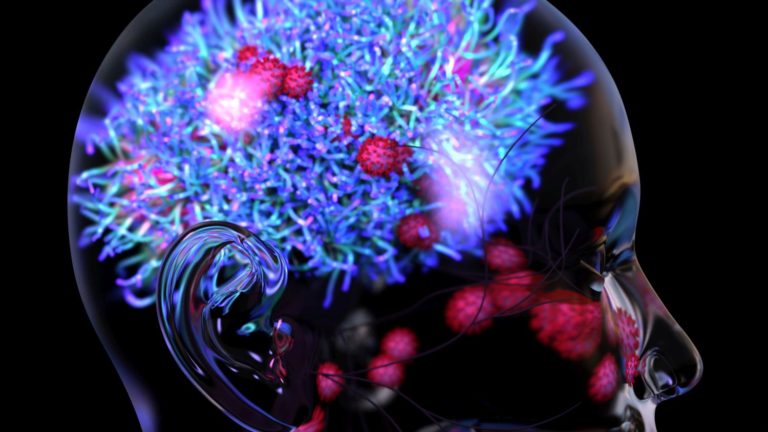The range of symptoms associated with COVID-19 and how the brain and nervous systems might be affected show signs for concern
In March 2020—still the early days of the U.K.’s COVID-19 crisis—Rhys Thomas, a neurologist at Newcastle University, got a call at home from a concerned colleague. The colleague’s cousin was hospitalized, critically ill with COVID-19, and had developed brainstem encephalitis, a severe inflammatory condition of the brain causing a suite of symptoms, from eye problems to balance problems and drowsiness. He wanted to know if Thomas knew anything about these conditions. At the time, the research coming out of Wuhan, China, only suggested a mild whiff of neurological symptoms—headache, dizziness, and the loss of taste and smell. Clearly the virus could affect the brain in some ways, but it wasn’t, Thomas thought then, anything serious. But this report sounded much more concerning. Symptoms like this patient’s would mean the virus was accessing more of the nervous system than scientists originally thought.
In the weeks and months following that call, Thomas (Figure 1) and other neurologists began seeing similarly alarming symptoms in COVID-19 patients around the world—inflammation of the brain and spinal cord, epileptic seizures, extreme muscle fatigue, and weakness resembling multiple sclerosis and stroke—all in patients without a prior disposition. “It was then that we realized there was probably more to the story than what we had been told,” Thomas said.
Today, as the pandemic has reached full flower, the range of symptoms associated with COVID-19 have become increasingly more insidious. What was at first thought to be mostly a pulmonary issue is now known to affect numerous systems, including, most devastatingly, the brain. While most patients experience minor symptoms—headache, fatigue, sleepiness, memory problems, and brain fogginess—the most severely affected patients experience symptoms ranging from difficulties with walking and moving, to stroke, and even psychiatric illness like psychosis, depression, and schizophrenia.

The field of what is now termed neuroCovid though is still incredibly new, and so certainty of any sort is hard to come by. Estimates of the prevalence rates range wildly, affecting anywhere from 6% to 84% of COVID-19 patients, according to a Lancet study published in October 2020 [1]. Scientists, meanwhile, are only barely beginning to understand what might be driving these neurological complications. And as the numbers tick up—in the United States alone exceeding 200,000 new cases per day and growing—the questions grow ever more urgent. Different symptoms require dramatically different treatments, and so not having answers continue to put a lot of patients at risk.
Inflammation
In the summer months of 2020, haunted by his colleague’s encephalitic cousin, Thomas joined a U.K.-wide, cross-institutional effort called the COVID-19 clinical neuroscience study, or COVID-CNS. Led by British neurologists Benedict Michael and Gerome Breen, the study is a collaboration among neurologists, psychologists, and psychiatrists designed to unpack the neurological and neuropsychiatric consequences of COVID-19.
Right now, much of the group’s work simply involves collating data. “We’ve had a whole number of odd cases referred to us that make us really scratch our heads and say, well, is this COVID-related or not?” He said. “We’ve seen a decade’s worth of hemorrhagic encephalitis appear in a short period of time, that has to be more than a chance occurrence.” But beyond tallying the numbers, they are also conducting a large biomarker study looking at genetics, immunology, and neuroimaging to unpack the mechanisms of disease. One of their biggest questions is whether neuroCovid is caused by inflammation or direct infection of brain cells.
At first glance, inflammation seems like the most likely culprit. One peculiar aspect of COVID-19 is that, somehow, the virus seems to be able to suppress the immune system for about ten days, so an infected person may not show any symptoms at all until, suddenly, the viral infection has spread so extensively throughout the body, it can be suppressed no more, and the immune system erupts with activity. Any significant infection, including a bad flu, can cause a massive release of cytokines—proteins that trigger an immune response—also known as a “cytokine storm.”
Though helpful to the body on a smaller scale, such massive immune reactions may have myriad negative consequences, including inflammation of the blood vessels. Inflamed blood vessels are narrower, causing limited bloodflow—ergo limited oxygen flow. It can cause minor symptoms like headache, decreased consciousness, fatigue, and confusion—as well as more extreme signs of minor encephalopathy—brain disease that alters its function. It would also explain some of the more severe symptoms doctors have seen in the course of treating COVID-19 patients such as clots causing stroke and bleeding, and extreme muscle weakness and numbness resembling Guillain-Barré syndrome, a rare condition in which the immune system attacks nerve cells. One Lancet Psychiatry study, published in June, found that of 125 patients with severe COVID-related neurological symptoms, 62% experienced stroke or brain hemorrhage.
In older individuals who lack robust cellular defense mechanisms to protect their brain cells, some increase in stroke wouldn’t be shocking. But with COVID-19, it’s not just older patients. All over the world, doctors are seeing upticks in stroke patients in their 40s, 30s, 20s—even children are showing signs of inflammation-associated heart disease and stroke. Erin Riggle, a pulmonary critical care physician in Littleton, CO, began to see young stroke patients with COVID-19 in April, and has been seeing them ever since (Figure 2). Nearly all are admitted to the intensive care unit (ICU) for stroke, and subsequently test positive for COVID-19. These days, “we test every patient who comes in with a stroke for COVID-19,” she said. At the moment, one of her ICU patients, a developmentally delayed, but otherwise healthy, woman in her early 30s, came in, unable to move her left side from a COVID-related stroke. If she recovers, she is unlikely to walk again, and may be prone to further neurological complications. The younger patients, said Riggle, are the really sad ones. “They have their whole lives ahead of them,” she said.

Infection
If inflammation alone were the only culprit, then early treatment with an anti-inflammatory steroid can, and does, fix the problem before things get bad. But that doesn’t always work, and there are other problems inflammation might not explain. “What was striking for us is that we also saw lots of mental health symptoms, including psychosis, hallucinations, delusions, and a slowing of brain waves,” said Thomas. Also, there’s the problem of the loss of taste and smell. All of that could be explained by inflammation, and yet it could also be explained by cell death, which would be indicative of the direct infection of neural cells. This is what ultimately concerned Kristl Vonck, associate professor in neurology at Ghent University Hospital, Belgium (Figure 3). “This is when we knew we had to be on our toes for neurological consequences,” she said.
According to a multicenter prospective European trial published in October, 2020, as many as 80% of COVID-19 patients experience the loss of taste and smell [2]. One plausible infection avenue could be this: the virus directly infects the cells of the nose and mouth—probably gaining entry by the ACE2 receptors on the cell walls, then it makes it way down to the lungs and kicks off an inflammatory immune response. But another route might look like this: the virus infects the nose and mouth and then, through cell pathways, enters the nervous system through the Vagus nerve—the longest and most complex of the cranial nerves, which control the parasympathetic nervous system (the system that regulates involuntary bodily functions like breathing, digestion and heartbeat)—killing brain cells without an inflammatory response. Some pathological studies have, in fact, shown that the virus can infect brain cells, but the data has yet to prove if the majority of neural complications happen this way. “For now, there are no autopsy studies of patients that have died from COVID where we have been able to demonstrate the presence of viral genetic material in the olfactory nerve fibers inside the brain,” said Vonck. Gathering such data would require sawing through bone, which sends viral particles into the air and risking the pathologists’ lives. Studies in mice, however, have demonstrated the virus can enter this way. If this is the case, it could explain why some patients have suddenly dropped dead without many other symptoms, something that’s been described in China. In fact, many of the mice studied die this way [3]. “These are of course hypothetical pathways,” she said.
Right now, it’s still an open question. Thomas thinks direct viral infection is unlikely. “I think it’s probably fairest to say it can, but it doesn’t in the majority of cases,” he said, “because if there was a direct viral invasion, you’d expect to see a lot of the virus in spinal fluid, and we very rarely pick that up.”

Treatments
The good news is that there are drugs that can block harmful neurological impacts before they start.
Alysson Muotri, a professor of neurology at the University of California, San Diego, School of Medicine (Figure 4), is studying potential drug therapies for brain cells using a model of brain organoids, a stem cell model of the human brain that exists outside the body. “We used antivirals that are already available to see if they can block the virus from replicating,” he said, selecting drugs made to tackle viruses with a similar genomic sequences to COVID-19.

Interestingly, the structure of COVID-19 very closely resembles Hepatitis-C, for which there happens to be one highly effective drug to treat it, Sofosbuvir or Sovaldi, the antiviral drug best known as the ferociously expensive half-million dollar cure for Hepatitis-C. It works by blocking the polymerase enzymes the Hepatitis virus uses to replicate. Muotri’s early results have shown that the drug seems to be equally as effective for COVID-19, though his study was quite small, consisting of brain organoid models of just three patients. “We didn’t see huge variations between models,” he said, “but it was not extensively tested in people.” Nonetheless, the fact that the drug is already preapproved for another condition and has minimal side-effects means it could be fast-tracked for clinical trials. Meanwhile, Muotri continues to test other, cheaper drugs, which he hopes might ultimately identify a similarly effective option that’s accessible to more patients.
Another, nonpharmaceutical method may also exist that might activate an immune response before the virus spreads to the brain. Vonck, who studies the role of the Vagus nerve in epilepsy, is investigating whether or not a type of pacemaker therapy for epilepsy might also work for a COVID-19 infection. Vagus nerve fibers connect to most of the body’s major internal organs, including the heart, stomach, and bowels. About a decade ago, it was discovered that the Vagus nerve could sense an inflammatory state within the organs, and communicate directly with the brain, which helps regulate it. It’s a route of communication that’s much faster than the relatively slower cytokine response, and thus might mitigate the need for the cytokine storm. Studies investigating the technology for treating chronic inflammatory disorders like rheumatoid arthritis already existed. Currently, it’s just a hypothesis, and implanting patients with pacemakers is impractical, but luckily, there are devices that can be placed on the neck that similarly activate the Vagus nerve called noninvasive vagus nerve stimulation (nVNS). One American study, published in Neuromodulation, found that two COVID-19 patients with pulmonary and mild neural symptoms (headache and fatigue), when stimulated every few hours a day, seemed to experience a reduction in symptoms without the assistance of drugs [4]. The results were promising, but like many of these early studies, still quite small and limited. At this point, said Vonck, “this is merely a hypothesis, but it has become very interesting because we need more than just steroids,” to treat severe inflammation from COVID-19.
The devil in the details
The sheer number of patients the pandemic has produced, and the rush of studies to try to learn and help is creating a firehose of data—but it’s hard to know how useful these data are in providing the critical insight physicians need to develop proper treatment protocols. One reason for that is patients are avoiding the emergency room, unless they experience major illness. That means minor neurological symptoms might be missing from the evidence base. “It is important that we create awareness among neurologists and ICU doctors so that they are aware they need to keep their eyes out for neurological symptoms,” said Vonck. Symptoms like headache, drowsiness, decreased consciousness, seizures, and perhaps most importantly, muscle weakness, need to be reported. “We need databases collating patient data in a standardized way,” said Vonck. European and American Academies of Neurology, for instance, have published guidelines for neurologists treating Covid patients [5].
For Riggle, as is the case for so many physicians in the trenches, it has changed how she treats patients. Today, every stroke patient gets a COVID-19 test, and she’s always on the lookout for evidence of neurological complications. And as for her own mental health, being in the trenches has been hard, but, “I think I’m doing okay,” she said.
References
- R. Helbok et al., “NeuroCOVID: It’s time to join forces globally,” Lancet Neurol., vol. 19, no. 10, pp. 805–806, 2020.
- D. Salmon Ceron et al., “Self-reported loss of smell without nasal obstruction to identify COVID-19. The multicenter Coranosmia cohort study,” J. Infect., vol. 81, no. 4, pp. 614–620, 2020.
- B. Bonaz, V. Sinniger, and S. Pellissier, “Targeting the cholinergic antiinflammatory pathway with vagus nerve stimulation in patients with COVID-19?” Bioelectron. Med., vol. 6, no. 1, pp. 15, 2020.
- P. Staats et al., “The use of noninvasive vagus nerve stimulation to treat respiratory symptoms associated with COVID-19: A theoretical hypothesis and early clinical experience,” Neuromodulation: Technol. Neural Interface, vol. 23, no. 6, pp. 784–788, 2020.
- E. Moro et al., “The International European Academy of Neurology survey on neurological symptoms in patients with COVID‐19 infection,” Eur. J. Neurol., vol. 27, no. 9, pp. 1727–1737, 2020.



